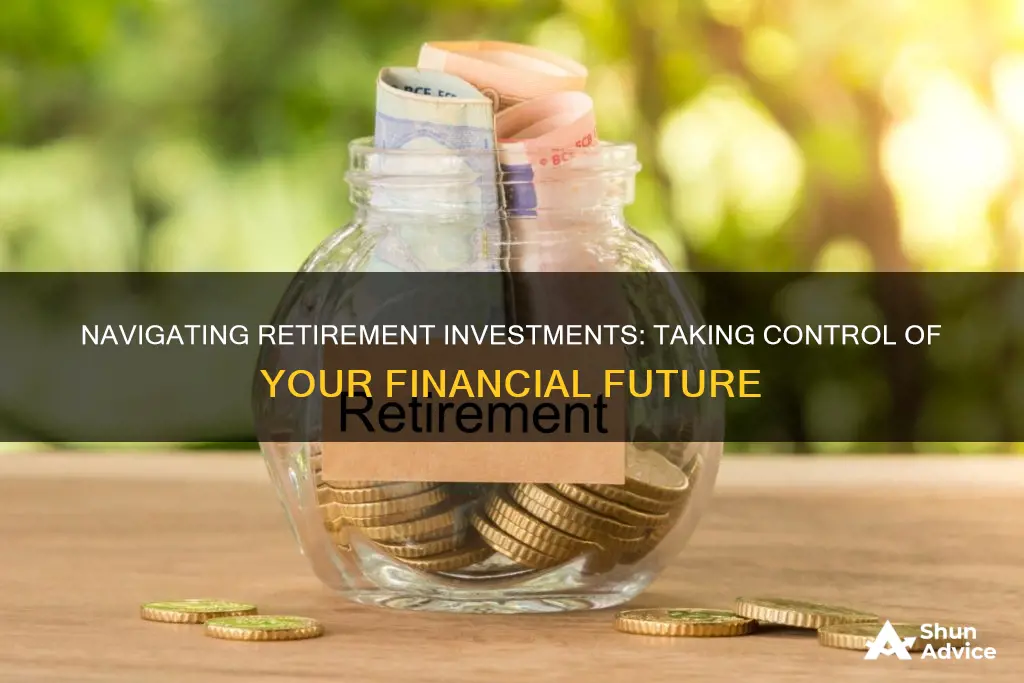
Choosing your own investments for retirement can be a daunting task, but it's an important part of planning for your financial future. Here are some key steps to help you get started:
- Set clear goals: Determine how much you want to save for retirement and create a plan to achieve that goal. This may involve increasing your income, reducing debts, and budgeting.
- Understand your options: Research the different types of retirement accounts available, such as 401(k)s, IRAs, and employer-sponsored plans. Each has its own advantages and contribution limits, so it's important to understand which ones are best suited to your needs.
- Assess your risk tolerance: Consider your age, investment horizon, and comfort with risk. This will help you determine the right mix of stocks, bonds, and other investments for your portfolio.
- Diversify your investments: Diversification is a key strategy to reduce risk and maximise returns. Spread your investments across different asset classes, industries, company sizes, and geographic regions.
- Monitor and adjust: Regularly review the performance of your investments and make adjustments as needed. As you get closer to retirement, you may need to rebalance your portfolio to reduce risk.
- Seek professional advice: If you're unsure about how to choose your own investments, consider consulting a financial advisor or using a robo-advisor, which can provide low-cost investment recommendations based on your goals and risk tolerance.
| Characteristics | Values |
|---|---|
| Investment type | Mutual funds, index funds, ETFs, stocks, bonds, annuities, real estate, cash-value life insurance plans, nonqualified deferred compensation plans |
| Risk tolerance | Depends on age and personal preference |
| Age | The younger the investor, the more they should invest in riskier stock funds |
| Income | Save 10-15% of income |
| Debt level | N/A |
| Other financial goals | N/A |
| Tax advantages | Yes |
| Employer match | Yes |
| Asset allocation | Depends on age and risk tolerance |
| Fees | Low fees are preferable |
| Investment horizon | Depends on age |
| Investment research | Research funds on Morningstar and Google |
What You'll Learn

Understand tax-advantaged retirement accounts
Tax-advantaged accounts are a great way to save for retirement, as they offer tax benefits that encourage you to reach your savings goals. There are two main types of tax-advantaged accounts: tax-deferred accounts and tax-exempt accounts.
Tax-Deferred Accounts
Tax-deferred accounts, such as traditional 401(k) plans and traditional Individual Retirement Accounts (IRAs), allow you to contribute pre-tax income, reducing your taxable income for the year. Taxes are then paid when you withdraw the money during retirement. This can be beneficial if you expect to be in a lower tax bracket during retirement. However, withdrawals from these accounts are typically taxable, and early withdrawals may result in penalties.
Tax-Exempt Accounts
Tax-exempt accounts, such as Roth 401(k) plans and Roth IRAs, are funded with after-tax dollars. This means you don't get an immediate tax break, but the money grows tax-free, and qualified withdrawals during retirement are usually tax-free. With Roth accounts, you have more flexibility to access your contributions without penalties, and there are generally no required minimum distributions during your lifetime.
Other Tax-Advantaged Accounts
In addition to retirement accounts, there are other types of tax-advantaged accounts that can help you save for specific goals:
- Health Savings Accounts (HSAs): HSAs allow you to set aside pre-tax income for qualified medical expenses. Contributions are tax-deductible, and withdrawals are tax-free if used for eligible health-related costs.
- 529 Plans: These accounts are designed for saving for education expenses, such as college tuition or K-12 private school tuition. Contributions are made with pre-tax income, and withdrawals are tax-free when used for qualifying educational costs.
- Coverdell Education Savings Accounts: Similar to 529 plans, these accounts offer tax-free growth and withdrawals for qualified education expenses. However, contributions are made with after-tax income and are not tax-deductible.
By utilizing these tax-advantaged accounts, you can maximize your savings, reduce your tax burden, and take control of your financial future.
Dutch Investment Apathy
You may want to see also

Learn about asset allocation
Asset allocation is the diversification of your retirement account across stocks, bonds, and cash. It's about finding the right mix of risk and return potential for your investments.
- Basic Concepts: Understand that stocks offer the best long-term growth potential but can be volatile, while bonds preserve capital with limited returns, and cash assets are risk-free but earn minimal returns. The goal is to find an optimal mix of these assets based on your risk tolerance and financial goals.
- Age Considerations: Your age plays a significant role in asset allocation. Generally, the younger you are, the more risk you can take. As you get older, it's advisable to shift towards more conservative investments. Rules like the Rule of 100 and Rule of 110 suggest holding a certain percentage of stocks based on your age, but these don't account for individual risk tolerance.
- Risk Tolerance: Evaluate your risk tolerance by considering how comfortable you are with market volatility and potential losses. If you have a large Social Security benefit or pension income, you may be able to tolerate more risk. Remember, all investing involves some level of risk, and it's essential to keep your volatility aligned with your income and growth goals.
- Investment Choices: Not all stock and bond investments carry the same risk. For example, small-cap stocks or emerging-market funds tend to be more volatile than broad large-cap index funds. Similarly, there is a range of risk levels within bond investments, from short-term Treasuries to high-yield corporate bonds. Choose investments that align with your risk tolerance and financial goals.
- Periodic Reevaluation: Asset allocation isn't a one-time decision. It's crucial to reevaluate your asset allocation periodically throughout your retirement, especially after major life changes or significant shifts in the performance of your investments. Your risk tolerance and financial goals may evolve over time, so adjust your allocation accordingly.
- Guidelines and Advice: While there are general guidelines, such as those provided by the Rule of 100 and Rule of 110, consider seeking advice from a financial advisor. They can help you create a comprehensive financial plan that takes into account your unique circumstances, including your risk tolerance, financial goals, and life expectancy.
Morningstar's Guide for Senior Investors
You may want to see also

Weigh up robo-advisors and target date funds
Robo-advisors and target date funds are both popular investment options for those looking for a hands-off approach to building and managing a portfolio. However, there are some key differences to consider when weighing up the two.
Robo-advisors are digital services that use algorithms to build and manage a client's portfolio and provide investment advice. They tend to be more flexible and can build more complex portfolios suited to a variety of needs. They take into account factors such as age, risk tolerance, income, current savings and goals. Robo-advisors typically charge a management fee, which can range from 0.25% to 0.89% of invested assets annually, in addition to the expense ratios of the funds they invest in. Some robo-advisors also offer access to human advisors for an additional fee.
Target date funds (TDFs), on the other hand, are mutual funds designed for retirement savings, serving as a diverse investment portfolio in a single fund. They are a one-size-fits-all investment type that automatically adjusts its holdings over time to reduce volatility and risk as the target retirement date approaches. Target date funds only charge an expense ratio, which can be as low as 0.08%. However, they are less personalised than robo-advisors and are not suited for those with more varied financial situations or multiple financial goals.
When deciding between a robo-advisor and a target date fund, it's important to consider your individual needs and circumstances. Robo-advisors offer more personalisation, flexibility and advanced investment strategies, but they also tend to be more expensive. Target date funds, on the other hand, are simpler, more straightforward and usually have lower fees.
Young Investors: Emulate Warren Buffett's Strategy
You may want to see also

Consider dividend-paying stocks
Dividend-paying stocks can be a great option for retirees looking for a consistent income stream. Dividends are payments made by companies to their shareholders, typically in cash but sometimes in the form of additional stock. Dividend-paying stocks offer retirees the opportunity to earn income from their investments without having to sell any shares. This can provide a steady stream of income to cover living expenses during retirement.
When choosing dividend-paying stocks for retirement, it is important to consider the following factors:
- Company Performance and Free Cash Flow: Look for companies that can afford to make consistent dividend payments from their free cash flow. Avoid companies with high dividend yields that have had lacklustre performance, as they may struggle to maintain their dividend payments.
- Dividend Growth and Sustainability: Ideally, you want to invest in companies with a history of increasing their dividends over time. This indicates that the company is committed to returning value to its shareholders and can sustain dividend payments in the long run.
- Diversification: Diversifying your portfolio across different dividend-paying stocks from various sectors can help reduce risk. Consider investing in 20-40 different dividend stocks and ensure that no more than 25% of your portfolio is invested in any single sector.
- Risk and Reward: Chasing high dividend yields can be tempting, but it's important to understand the risk/reward ratio. Very high yields may indicate that the company is in financial distress, so always do your due diligence before investing.
- Tax Implications: Dividends are typically taxed at a higher rate than capital gains. Consider the tax implications of dividend income and how it will affect your overall retirement income.
- Reinvestment: Reinvesting your dividend income back into dividend-paying stocks can help compound your returns over time and grow your portfolio.
Remember, while dividend-paying stocks can be a great addition to your retirement portfolio, they should not be your only investment strategy. Diversification across different asset classes and investment types is crucial to building a well-rounded retirement portfolio.
Lucrative Options: Exploring 5% Returns on Investments
You may want to see also

Think about buying rental property
Rental properties can be a good source of retirement income. Real estate is an inefficient market, which means that it's possible to find bargains with high returns on investment. You can also collect more income if you manage the property yourself.
However, there are some things to keep in mind before investing in rental properties for retirement:
- Financing – If you plan to finance your purchase with a mortgage, it's best to do so before you retire. Mortgage lending guidelines typically require that applicants be employed and have a steady employment history. Lenders also usually require a substantial down payment (30% or more) if the buyer won't be occupying the property.
- Costs – In addition to the purchase price, don't forget about the costs of the transaction itself, such as agent commissions. There are also recurring expenses associated with owning rental property, such as maintenance and marketing costs, and vacancy periods.
- Location – Choosing a good location is more important than simply finding the cheapest property. Look for areas with high employment opportunities, such as near a college campus or downtown. The location should also match the current demographic of the area, such as whether it's populated with single adults or families, to ensure you can find suitable tenants.
- Income – You should aim to earn about 8% per year on your investment after costs. This will compensate you for the risk and illiquidity of your investment.
- Management – Rental property isn't a completely passive investment. If you don't want to or can't manage the property yourself, you'll need to hire a property management company, which will further eat into your profits.
Overall, investing in rental properties can be a good way to generate income for retirement, but it's important to do your research and carefully consider all the associated costs and responsibilities.
Understanding Investment Pay Periods: Unlocking the Timeline of Returns
You may want to see also
Frequently asked questions
The first step is to set up a retirement account, such as a 401(k) or an individual retirement account (IRA). You can then start contributing a portion of your income to this account, ideally aiming for between 10% and 15%.
It's important to understand your risk tolerance and investment horizon. Generally, younger people can afford to take on more risk by investing in riskier stocks, whereas older people should be more conservative and opt for safer investments like bonds.
Financial advisors often recommend the formula: 110 minus your age equals the percentage of your portfolio that should be invested in stocks. The rest should be in bonds.







